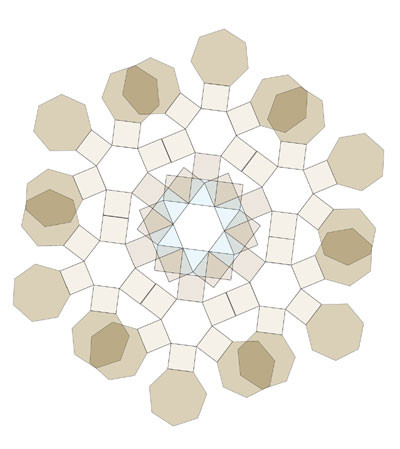Joe Scanlan
12 Mar - 12 Apr 2008
JOE SCANLAN
"Creative Destruction Traveling Salesman Circular Economy"
Opening: Tuesday, March 11, 2008, 7 p.m.
Exhibitions runs: March 12 – April 12, 2008
Galerie Martin Janda
Raum Aktueller Kunst
A-1010 Wien, Eschenbachgasse 11
Tue-Fri 1 p.m.-5 p.m., Sat 11 a.m.-3 p.m.
From March 12 to April 12, 2008, Galerie Martin Janda is showing Creative Destruction Traveling Salesman Circular Economy, the American artist Joe Scanlan's third personal in Vienna. Scanlan, born 1961 in Circleville (Ohio, USA), lives in New York and teaches at Yale University School of Art.
Creative Destruction
In this space-filling wall piece completed in 2008, Joe Scanlan deals with a text by Joseph A. Schumpeter (1883–1950), an economist of Austrian descent. Schumpeter’s most widely known idea – published in 1942 in Capitalism, Socialism and Democracy – is “Creative Destruction”: it addresses how in economic life old ways of doing business are destroyed in the process of new ways coming into being. Scanlan applies this theory of the essence of capitalism to art by changing, rewriting and rearranging Schumpeter’s text and by inserting words and phrases. Through Scanlan’s revisions – recognizable due to the artist’s use of different shades of blue – Schumpeter’s text itself becomes the subject of a creative destruction process. By transferring it to the gallery’s walls it also simultaneously becomes a tableau which visitors to the exhibition enter; accompanying their movement is an altered perception of the text and space.
“Schumpeter is interesting to me because, while he agrees that each succeeding generation needs to contradict and destroy what came before it, he locates this drive not in authorship but in economic survival. Destruction is not an intellectual critique of previous forms and institutions, but a necessary process for making those forms and institutions profitable again. The conventional view of artistic change (the avant-garde) is: What can I say that is unique? My view, supported by Schumpeter’s theory, is: What can I do that is profitable?” (Joe Scanlan)
Circular Economy
In the video installation Circular Economy, 2005, Scanlan again turns his attention to economic processes: the term describes an economic concept in which a firm utilizes another manufacturer’s residual material or waste products in its production. Working “in a circle”, Joe Scanlan and five other artists (Gabe Greenberg, Sean Herman, Diego Rotalde, Erin Shirreff and Jeff Warren) created the animated film loop with soundtrack which is being shown in the gallery’s basement.
Traveling Salesman
Scanlan’s Traveling Salesman, 2006, a portable folding table holding selected editions and publications by the artist, investigates – as did earlier works – the idea of the retail display. In the age of online shops and overnight shipping, the image of the traveling salesman and his accoutrements has come to seem absurd. Traveling Salesman functions as an offline version of Scanlan’s website www.thingsthatfall.com, from which the artist distributes his editions, publications and artwork.
"Creative Destruction Traveling Salesman Circular Economy"
Opening: Tuesday, March 11, 2008, 7 p.m.
Exhibitions runs: March 12 – April 12, 2008
Galerie Martin Janda
Raum Aktueller Kunst
A-1010 Wien, Eschenbachgasse 11
Tue-Fri 1 p.m.-5 p.m., Sat 11 a.m.-3 p.m.
From March 12 to April 12, 2008, Galerie Martin Janda is showing Creative Destruction Traveling Salesman Circular Economy, the American artist Joe Scanlan's third personal in Vienna. Scanlan, born 1961 in Circleville (Ohio, USA), lives in New York and teaches at Yale University School of Art.
Creative Destruction
In this space-filling wall piece completed in 2008, Joe Scanlan deals with a text by Joseph A. Schumpeter (1883–1950), an economist of Austrian descent. Schumpeter’s most widely known idea – published in 1942 in Capitalism, Socialism and Democracy – is “Creative Destruction”: it addresses how in economic life old ways of doing business are destroyed in the process of new ways coming into being. Scanlan applies this theory of the essence of capitalism to art by changing, rewriting and rearranging Schumpeter’s text and by inserting words and phrases. Through Scanlan’s revisions – recognizable due to the artist’s use of different shades of blue – Schumpeter’s text itself becomes the subject of a creative destruction process. By transferring it to the gallery’s walls it also simultaneously becomes a tableau which visitors to the exhibition enter; accompanying their movement is an altered perception of the text and space.
“Schumpeter is interesting to me because, while he agrees that each succeeding generation needs to contradict and destroy what came before it, he locates this drive not in authorship but in economic survival. Destruction is not an intellectual critique of previous forms and institutions, but a necessary process for making those forms and institutions profitable again. The conventional view of artistic change (the avant-garde) is: What can I say that is unique? My view, supported by Schumpeter’s theory, is: What can I do that is profitable?” (Joe Scanlan)
Circular Economy
In the video installation Circular Economy, 2005, Scanlan again turns his attention to economic processes: the term describes an economic concept in which a firm utilizes another manufacturer’s residual material or waste products in its production. Working “in a circle”, Joe Scanlan and five other artists (Gabe Greenberg, Sean Herman, Diego Rotalde, Erin Shirreff and Jeff Warren) created the animated film loop with soundtrack which is being shown in the gallery’s basement.
Traveling Salesman
Scanlan’s Traveling Salesman, 2006, a portable folding table holding selected editions and publications by the artist, investigates – as did earlier works – the idea of the retail display. In the age of online shops and overnight shipping, the image of the traveling salesman and his accoutrements has come to seem absurd. Traveling Salesman functions as an offline version of Scanlan’s website www.thingsthatfall.com, from which the artist distributes his editions, publications and artwork.

